
June 13th 2005
This weekend Yuriko and I went to World Expo 2005, in Aichi. As a result, last week was very busy as I tried to get all my work done before Friday, so that I would be free for the weekend. I did succeed, but as a result there's nothing much to talk about before Friday. Fortunately, the last three days of the week more than compensate.
Okazaki
With Art Fair Tokyo rapidly approaching, Yuriko can't take days off during the week. It takes quite a bit of effort to get weekends completely clear. However, while I'm busy, I'm still freelance and thus flexible. Since the Expo is very close to Okazaki, I wanted to go into Yamasa and say hello to various people while I had the chance. As a result, I left Tokyo on Friday morning, getting the Shinkansen to Toyohasi, and then the express to Okazaki.
Okazaki has changed a lot since I was last there. Seriously. The area between the railway station and the school has been almost completely remodelled. The building and demolition work had started before I left, but it's now nearly complete. The main route to school no longer goes right outside the porn cinema, and the really narrow road has been widened and given a pavement, so it's not nearly as dangerous as it used to be.
Even school has changed a lot. Most of the students are new, although I did bump into one I knew (Reka) as soon as I walked through the doors. (Reka read my review of Yamasa and bits of my diary before she came to Japan.) However, a lot of the teachers are new, as well. For some reason a lot of teachers left in April, so there weren't so many familiar faces.
Still, enough of my teachers were around to make it worth the visit. I had a nice chat with Nakane-sensei, and shorter chats with other teachers. Kondou-sensei gave me some very helpful advice about the Expo, of which more later.
A bit later in the afternoon, Kuroda-sensei interviewed me. When I emailed her to say that I was going to be in Okazaki, she asked if she could do an interview, but didn't really explain what it was. On the day, of course, she did explain. It seems that she has been studying to qualify as an examiner for a particular Japanese exam, and for the final test she has to do eight interviews with non-native speakers, rate them according to the standards, and then send tapes of the interviews, along with the ratings, to the exam board. She needed the interviews to cover a fairly wide range of ability, so I was recruited to fill a gap at one end. (The upper end, I hope.)
The interview seemed to go fine, and I'll find out what Kuroda-sensei thought my level was in the near future; she's promised to send me a copy of the assessment.
I had lunch, went to the post office (I'd been meaning to go in Tokyo all week, but hadn't had time), and in the evening chatted with Declan a bit. Then I headed off to Nagoya, to meet Yuriko at the station.
Nagoya
Yuriko was, unsurprisingly, a bit late. She'd had trouble getting away from work, which is standard at the moment. As I have mentioned before, albeit quite a long time ago, Yuriko's parents live in Nagoya, and we were going to stay with them. In fact, that was the main purpose of the visit; since Yuriko and I will start living together in the near future (just how near depends on how the process of buying a flat goes), it seemed a good idea to visit her parents. I've only met them twice, after all.
Fortunately, Yuriko's parents are very nice. They made delicious meals, and took us out for lunch on Saturday. We talked quite a bit, and I got to see the albums of Yuriko's baby pictures. She's changed quite a lot since then. In fact, on some of the pictures from nursery school there was extensive discussion as they tried to work out which small child was Yuriko. ("I think that one's a boy." "Hmmm, maybe this one. Didn't I have short hair then?" "She is quite close to the centre of the picture, isn't she?")
The plan was to visit the Expo twice, on Saturday evening and then all day on Sunday, before going straight to the train. This proved to be a good decision, as it rained, hard and solidly, all day on Saturday. By the evening, it was letting up a bit, and we set off for the Expo.
The 2005 World Exposition, Aichi, Japan
The official name of the Expo, in Japanese, is "Love-Earth Expo". This is a pun. First, the theme of the Expo is "Nature's Wisdom", and "Learning from and Living with Nature". Thus, "Love-Earth" is a good name for it. It's also a World Expo, so having "Earth" in the name makes sense.
However, in Japanese "love" is "ai" and "Earth" is "chikyuu". The expo is being held in Aichi. "Love-Earth Expo" is "Ai-Chikyuuhaku". Ba-dum. ("Aichi" is actually written with the characters for "Love Wisdom", so even the kanji for "Ai" is the same.)
Punning names aside, some people have raised questions about the theme of the Expo and its existence. The Expo site, you see, was an area of forested mountains and hills, previously undeveloped, which has been seriously built on and linked in to lots of new roads, railways, and other transportation routes. Even in Japan a few people felt that there was something of an internal contradiction here.
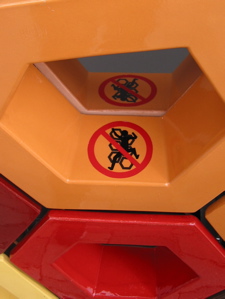 There are a lot of rules on the Expo site. "Spiderman Prohibited" is one of the stranger ones, however. (On the Spanish Pavilion.)
There are a lot of rules on the Expo site. "Spiderman Prohibited" is one of the stranger ones, however. (On the Spanish Pavilion.)
It certainly can't be denied that this didn't get the process off to the most consistent start possible. However, while in Europe it would be possible to do a World Expo on a brownfield site, abandoned by industry, Japan still has a manufacturing industry, and far too many people, so really, there's nowhere else to put it. There is a heavy emphasis on ecologically sustainable building technology, and on environmentally friendly transport, and the plan is to turn the whole site into a nature park once the Expo finishes at the end of November. We'll have to see how that turns out; I know a number of people are rather sceptical, and suspect that lots of blocks of flats will get built. After all, the transport links to the area are very good.
So, let us leave the internal contradictions of the whole project to one side, and talk about our visit. Immediate public transport access to the site is by Linimo, an elevated linear-motor train. (At least, I think that's what it is.) Yuriko's parents dropped us off at one of the stations, because you are not allowed to drop off at the site itself, and we rode the train two stops to the Kouen'nishi (Park West) station.
This was a result of the advice Kondou-sensei gave me. The main station for access to the park is Banpaku Kaijou (Expo Site -- not imaginative, but very informative). However, the West Gate, which is ten minutes' walk from Kouen'nishi, is much less crowded, because almost everyone goes to the main entrance. We got there just before five, because discounted admission to the site begins at five. (The site is open until ten.) There were a lot of people waiting. While you can buy all-day tickets in advance, you can only buy evening tickets on the day, so everyone had to line up to buy tickets and then line up again to actually enter. While Yuriko bought our evening tickets, I picked up my advance ticket (which was 700 yen cheaper, at 3,900 yen, than a full-price entry ticket), and bought Yuriko's ticket for Sunday as well.
When we met up, we found that Yuriko had also bought her Sunday ticket. Fortunately, although the tickets are nominally non-refundable, we found that they will give you a refund within two minutes of buying the ticket.
Entry to the park is like entry to an airport. Baggage is checked, drinks are confiscated (you have to buy drinks on site), and you walk through a metal detector. People who set the detector off get wanded, just like an airport. Obviously, this takes a bit of time, even with several dozen channels working in parallel.
Nevertheless, we did eventually get into the site. Yuriko had two things she really wanted to do: go to the Japan Pavilion, and see the exhibits for the Art Project (that was to do with work). I wanted to go to the UK Pavilion, and to the forest park in the east of the site.
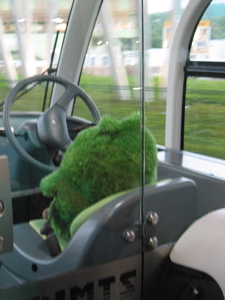 You can tell Morizo is a reliable driver. He has his seatbelt on, and never gets distracted by the passengers.
You can tell Morizo is a reliable driver. He has his seatbelt on, and never gets distracted by the passengers.
On Saturday, then, we first went to the Japan Pavilion, which is near the West Gate. The queue was over two hours long, and it wasn't possible to make reservations for the following day. So, we temporarily abandoned that, and rode the IMTS to the southern part of the site, where the UK pavilion is.
IMTS stands for Intelligent Multimode Transport System. It's a completely computer-controlled system. In fact, our driver was Morizo, the Expo mascot.
There are actually two mascots, Morizo and Kikkoro. They are, apparently, forest fairies. They look rather like animated compost heaps. Still, I suppose they're easy to draw.
Anyway, Morizo turned out to be a very safe driver, and we got to southern end of the site without incident. It's encouraging to see how much progress computer control of vehicles has made, but worth noting that no other vehicles are allowed on the IMTS road. When they can deal with traffic, they might actually be useful.
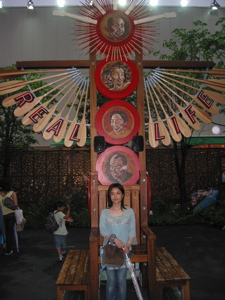 Yuriko sitting at the bottom of one of the sculptures in the UK Pavilion garden. It does say 'Please sit down' on the chair.
Yuriko sitting at the bottom of one of the sculptures in the UK Pavilion garden. It does say 'Please sit down' on the chair.
The queue for the UK pavilion wasn't very long, and we quickly got inside. The pavilion is divided into four parts. First is a sculpture garden. The art in the garden is all inspired in various ways by nature, or reactions to nature. For example, White House is a block of gypsum, roughly house-shaped, with water dripping on it. The water is eroding the stone in interesting, and entirely natural, shapes.
The second part has seven interactive displays, each showcasing a technology inspired by nature and developed in the UK. One dealt with tidal energy, another with the construction techniques used in the Eden Project, and another with ultrasound sonar canes for the blind.
The third part is the shop. All the pavilions have to have shops. (Perhaps wisely, the UK pavilion does not have a restaurant.)
Finally, along the exit, there are little bird houses containing images of natural areas from all across the UK.
Overall, I was very impressed with the UK pavilion. The general impression I got was of very thoughtful use of a somewhat limited budget. All the sections of the pavilion had clear links to the theme of the Expo (there were even National Trust goods on sale in the shop), while also showcasing aspects of the UK. This contrasts with a number of the other pavilions, which bore little or no relationship to the theme of the Expo, concentrating on showing off things you can buy from the country in question.
From there, we went to take pictures of one of the Art installations (giant garden gnomes emerging from the ground), before boarding the Kikkoro Gondola to the northern part of the site. This was just around sunset, and the view over the site was excellent. Boarding on the evening of a rainy day also had the advantage that there was no queue.
The northern part of the site houses the corporate pavilions: Hitachi, Mitsui, and, possibly the most popular, Toyota. (There are several others, as well.) It isn't possible to enter any of these pavilions without an advance reservation, so we gave up on all of them, although we did wander around to have a look at the outside.
Next to the corporate pavilions was the area for pavilions from north and central Asia. (The international pavilions are grouped into regions.) Yuriko wanted to visit the Korean Pavilion, and it really was worth a look. The emphasis was heavily on technology, and the centrepiece was a 13-minute animation, in 3D and displayed on an enormous high-definition television, showing robots destroying nature and then rebuilding it. It was quite impressive, although the narrative was somewhat limited by the need for anything in a language to be utterly non-essential. (There was a short Japanese prologue to set the scene, but that was all.)
From there, we decided to look around the pavilions in that area until it was time to go back to Yuriko's parents'. We popped into several, but the one that most impressed me was Bhutan.
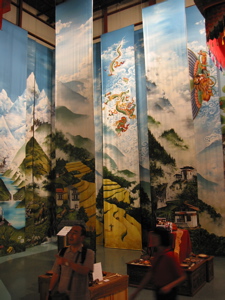 The banners corner in the Bhutan Pavilion.
The banners corner in the Bhutan Pavilion.
Here, there was a very heavy emphasis on introducing the country, which makes sense because I imagine a lot of people have never even heard of it. (It's towards the eastern end of the Himalayas.) However, it was clear that a lot of thought and work had gone into presenting the pavilion within the budget available. Entrance is up a ramp, and you are faced by a wall of pictures of the people and environment of Bhutan. The ramp turns a corner, bringing you face-to-face with a corner hung with enormous banners. This has quite an impact, more than some of the high-tech shows found in other pavilions. The banners depict the natural environment of Bhutan, along with a panel talking about the nature reserves there.
Next to the banners there is a Buddha statue, specially made for the Expo, in a traditional pavilion, also specially made. The route out of the pavilion takes you past explanations of Bhutan's wildlife, culture, and products, as well as a section of photographs of the Bhutanese royal family meeting various members of the Japanese royal family.
There was also a letter from the king of Bhutan to Japan, which shows that the eighteenth and nineteenth century traditions of royal communication have not entirely died out. It congratulates the Japanese people on achieving economic progress while keeping environmental impact to an absolute minimum. This is like congratulating the Roman emperor Titus on suppressing the Jewish rebellion with minimum disruption of their culture. (Historical note: Titus razed the Temple in Jerusalem to the ground and scattered the Jews across the Empire.)
The outrageous flattery of the letter notwithstanding, I thought the pavilion was very well done. Like the UK pavilion, it gave the impression of having been conceived as a whole, and with some thought to the nominal theme of the Expo. As a result of the visit, I am seriously thinking about visiting Bhutan, and as that will have been one of the aims, it must be accounted a success.
We also went in a few of the other pavilions there, but none were, overall, quite so impressive, although the ceiling of the Sri Lankan pavilion, covered in batik, is overwhelming. Quite a bit of the Sri Lankan pavilion is devoted to the aftermath of the tsunami, which I suspect may have forced the government to scale the pavilion back substantially; the things present did seem to rattle around inside the available space somewhat.
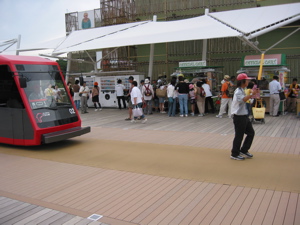 A World Expo is an opportunity to demonstrate advanced technology. In this case, a "car", which can be used to transport people long distances. However, it is dangerous, so a person must walk in front waving a stick to clear people out of the way.
A World Expo is an opportunity to demonstrate advanced technology. In this case, a "car", which can be used to transport people long distances. However, it is dangerous, so a person must walk in front waving a stick to clear people out of the way.
By this time it was getting on for nine pm, so we decided to head out. We were close to the north exit, so we went that way.
Mistake.
It took almost an hour to get out of the Expo site and onto the Linimo. Getting back to the underground station near Yuriko's parents' house took another hour, because we had some very long waits for trains. There was still some really delicious food waiting for us when we got back, though.
On Sunday, we were to spend the whole day at the Expo. On Saturday night we made a strategic decision not to go very early, since I was short on sleep and another early morning would likely have meant that I could not have made it through the day. The strategy worked; I was fine.
Yesterday's weather was better than Saturday's. There was no rain, and it wasn't as intensely hot as Japan can get. Indeed, by the late afternoon and early evening, it was positively pleasant.
We arrived at the site around ten, facing an enormous queue for the entrance, even at the West Gate. I shudder to think what the main gate must have been like. There were large numbers of staff keeping order, trying to keep everyone moving without having anyone move too fast. I don't know how many people were in the crowd, but a stampede would have been catastrophic. One of the staff, standing in front of us just before we got to the entrance, was making announcements through his loud-hailer.
"I truly understand just how much you want to get inside, but the Expo site isn't going to run away, so please move forward at a steady pace."
Once inside, we put our luggage in the coin lockers (there was still a large one empty), and then went to look at the Japan Pavilion. Reservations for the day were already closed, and waiting time for non-reserved entry was over two hours. However, Yuriko really wanted to go in, and I wanted to visit at least one of the really popular attractions, so we lined up.
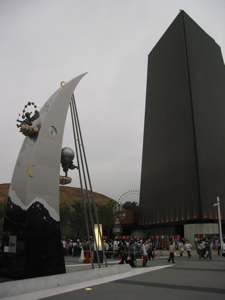 A view of the complex of Japan buildings. To the left is Japan Tower, 'The Moon'. To the right is Earth Tower, the Nagoya City pavilion. The brown bulge in the left rear is the Japan Pavilion itself.
A view of the complex of Japan buildings. To the left is Japan Tower, 'The Moon'. To the right is Earth Tower, the Nagoya City pavilion. The brown bulge in the left rear is the Japan Pavilion itself.
It wasn't too bad; we had plenty of time to chat while slowly, slowly, slowly making our way forward. The Japan Pavilion itself is probably the largest, as befits the host country pavilion. It is built almost entirely of wood and other biological materials, in a rather organic shape. There are plants growing in the walls, and a constant flow of treated waste water over the roof. After the long queue, it takes about forty minutes to see the interior.
The first room is a walkway surrounded by screens on which various scenes from around the world are projected, ranging from glaciers to forest fires. This leads into an antechamber where animations depict the changes in Japanese society over the last sixty years, where you wait before entering a display of Japan over sixty years. Each decade has representative goods, and depictions of the natural environment. The next antechamber shows the Earth in space, with the magnetosphere. That leads to the Earth Room.
This is the centrepiece of a pavilion, a spherical high definition television set that completely surrounds you with images of the world. It is really very spectacular. The audience stand on a walkway that runs through the middle, and the edges of the walkway are transparent, so that you can look down and see the screen below you as well.
From there, you enter an artificial forest, where various displays explain about the pavilion, and about other environmentally friendly technology developed in Japan. One interesting exhibit was the nano-bubbles tank. This is a fish tank, with both fresh and sea water fish in it. The nano-bubbles, developed in Japan, make it possible for them to share the same water. The explanatory card was a bit vague on practical uses for the technology, which makes me wonder whether they're still trying to work out what to do with it.
Overall, we spent about three hours getting into and around that pavilion, so we were quite hungry when we got out. Yuriko needed to see the other Art Programme installations, so we headed over to the South-East Asia/Oceania area, both to see another one and to get lunch. Lunch was OK, although I wouldn't recommend going to the Expo particularly for the food.
The first pavilion we went in was the Vietnamese pavilion. I think this pavilion probably had a stronger emphasis on 'buy our goods' than any other we visited, which is a little odd for a Communist country. It worked, though; Yuriko bought a very nice all-silk shoulder bag, with a flower design. I took a few photos in there, because I want to ask Hang just how typical the 'typical traditional house' is. I have my doubts.
We popped into a few other pavilions, including the Malaysian Pavilion. In many ways, my impression of the Malaysian Pavilion was the opposite of my impression of the UK Pavilion: a large budget, spent without enough thought given to the over-all pattern. It was impressive, but somehow seemed to lack heart. Or maybe I was just getting tired by this point.
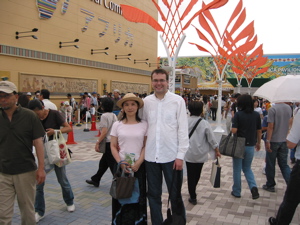 Yuriko and me in the Africa region of the Expo.
Yuriko and me in the Africa region of the Expo.
Around this point we had to start keeping an eye on the time, so we stopped looking in pavilions and concentrated on finding and photographing the art installations. This took us through the southern Europe area, and into the African area, where we found someone to take our picture. The Egyptian Pavilion was notable for its Ancient Egypt theme. I wonder whether the interior covered things that have happened there in the last three thousand years, as well.
Also in the African area was the NEDO Pavilion, which had an exhibition of prototype robots. I would have quite liked to visit that, but the waiting time was over two hours, and one of those was quite enough. One reason I wanted to see it is that the Japanese attitude to robots is substantially different from the Western (US/British) attitude. In broad terms, the Japanese want robots to come and live with them. They are not, in general, afraid of robot warriors taking over the world. It would have been interesting to see how far that had progressed.
So, having visited all but one of the installations (although we had completely failed to spot the work of art at one location; this is one of the problems of some contemporary art), it was my turn to get to go where I wanted again. The eastern part of the site is still wooded hills, and there are trails through them. The weather was beautiful at this point, so we went to the northern forest path.
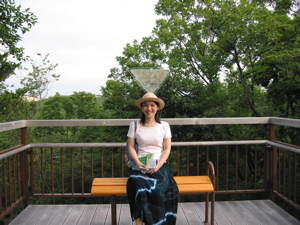 Yuriko on the forest trail, in front of part of one of the art installations.
Yuriko on the forest trail, in front of part of one of the art installations.
As I had expected, it was almost deserted. There were actually times when we couldn't see anyone else. Although the woods around the path were clearly there before the Expo, the path itself was almost entirely a raised walkway, and the woods themselves were fenced off even when the path ran along the ground.
The upper part of the path, which ran to a viewing platform, was lined with various works of art, inspired by nature. There were a large number of small stone animals (painted rocks), including a couple of whales, which didn't strike me as terribly plausible inhabitants of a forest. There were also a lot of more abstract installations, which meant that Yuriko was very happy taking pictures.
The view from the platform was superb. It looked out across the Expo site to the city, and then the mountains beyond that.
Overall, I think that walk captured the spirit of the Expo very well. Despite all the claims to be close to nature, it is still a very man-made and regulated experience. Nevertheless, it does draw in a wide range of themes, and at least has the potential to make you think.
After the walk, we had time to visit the last of the art installations, before heading home. Since we were leaving earlier, it was much easier to get out of the site, onto the Linimo, and then to the interchange station for the shuttle train to Nagoya. That train has ten carriages, but most people were still lining up for the first four or so. Yuriko and I walked to the end of the platform, and thus had lots and lots of space in our carriage.
We got our Shinkansen with no problems, and arrived back in Tokyo as planned.
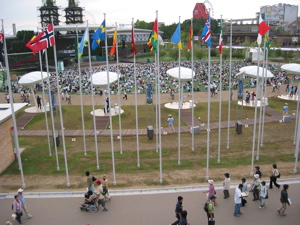 The World Exposition 2005, Aichi, Japan.
The World Exposition 2005, Aichi, Japan.
So, what did I think of the Expo? I'm very glad I managed to go. While I don't think it's quite worth a special trip from the UK or USA to visit, unless you are really interested in Expos, it is very definitely worth a visit if you are in Japan while it's happening. If you're in Okazaki studying at Yamasa, it's almost criminal not to go.
I'd recommend using the West Gate to get in and out (he says, taking the risk of completely throwing off the Expo group's traffic flow plans); there is a bit of a walk, but it really does seem less crowded. If you can manage to be in the area for two days, doing an evening (at half price) and a full day seems to be a good plan, but there's more than you can possibly see, even in that amount of time. On a purely practical note, the toilets near the main attractions tend to be very busy; going just a little bit out of the way can reduce the queues enormously. If you can wait long enough to stand in the queue, you can wait long enough to not need to queue. On our way home, Yuriko and I were both talking about the possibility of visiting again before the Expo finishes, because there was so much that we didn't see; we didn't visit any of the Americas pavilions, any of the Africa pavilions, or any of the southern Europe pavilions. Thus, there are bound to be amazing attractions I know nothing about.
I think it's a good idea to visit at least one of the really popular pavilions. The Japan Pavilion was the only one I went to, and that was worth it, so I imagine the others are the same. I'd also recommend the UK pavilion, as a well-planned, relatively low-key experience. (Very British, really.) Of the more obscure attractions, I highly recommend the Bhutan pavilion, as may have been obvious from my comments earlier. If the weather is good, the north forest trail is well worth a visit, at least in part because there is an excellent chance that you will be able to get away from the crowds for a while.
Overall, an excellent weekend.